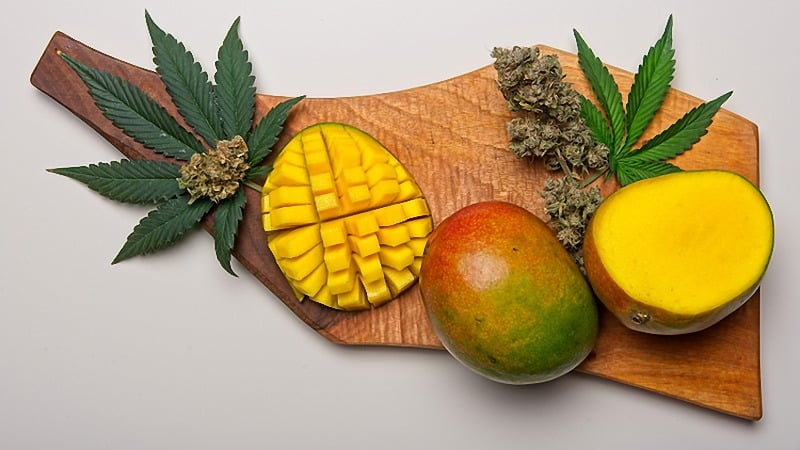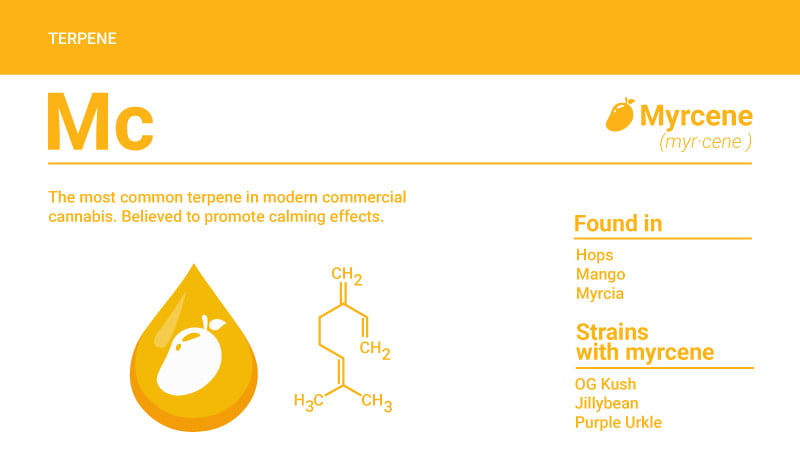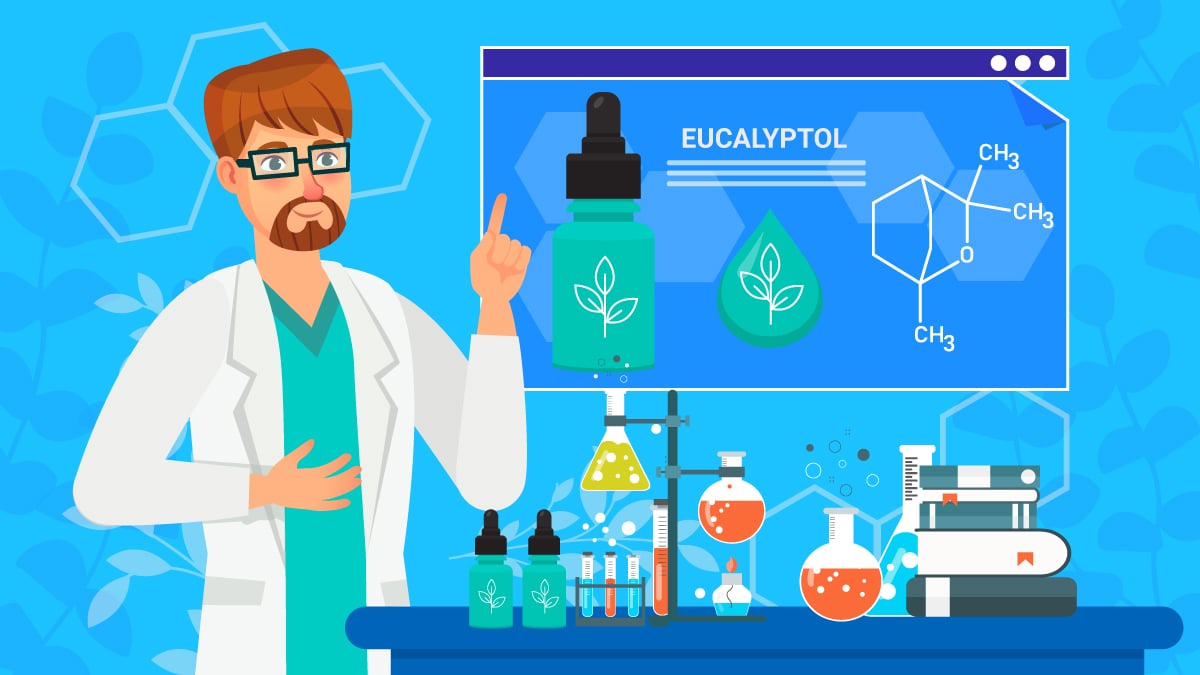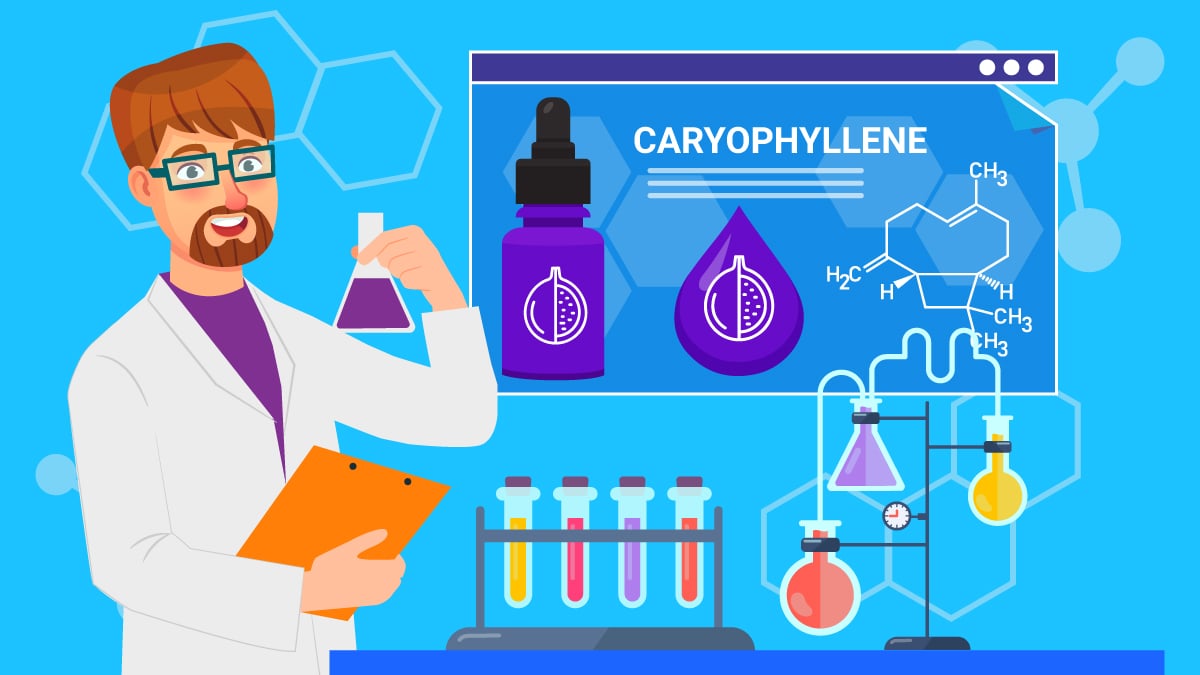Myrcene Terpene: Strains, Effects, Dosage, & More
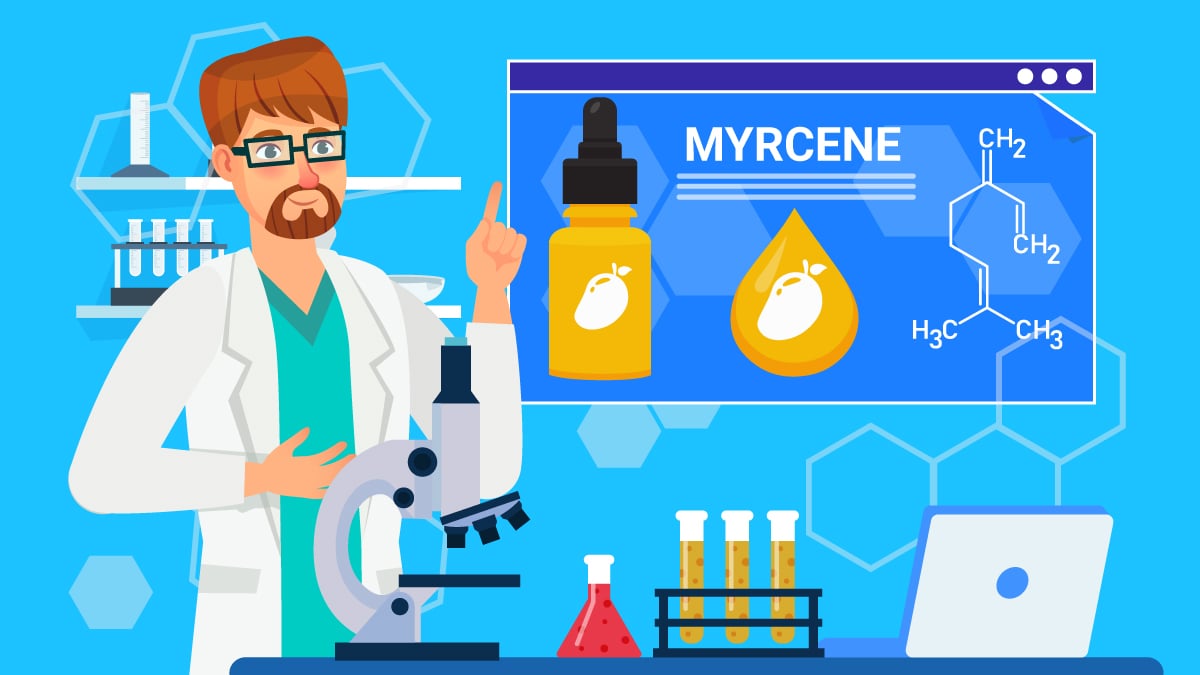
Typically, a cannabis plant will produce over 100 different terpenes.
There’s still a plethora of research that needs to be conducted; we’re just beginning to understand some of these more common compounds.
Here, we’ll be covering one in particular — a terpene called myrcene.
Explore what makes this common terpene so useful, what the research says about it, and how to use it safely.
What is Myrcene?
Myrcene is sometimes referred to as the “mother of all terpenes” for its wide-ranging health benefits.
The word myrcene is named after a medicinal shrub from Brazil by the name of Myrcia sphaerocarpa. It’s also the active element of lemongrass that gives it sedating properties.
Other common sources of myrcene include hops, cannabis, mangoes, and basil, to name a few.
What is a Terpene?
Terpenes are naturally-produced aromatic compounds consisting of simple carbon, hydrogen, and the occasional oxygen atoms. There are thousands of combinations of these elements that make each terpene unique.
There are estimated to be more than 30,000 individual terpenes in existence.
Many things found in nature, like fungi and herbs — not just cannabis — are chock-full of terpenes.
Terpenes are important for a variety of reasons. For example, pollinators use them to find where the flowers are so they can extract their nectar. Some terpenes have the opposite effect — repelling potential predators and insects.
Some plants even use terpenes to improve the flavor of their fruit. Plants can entice wild animals and humans to perpetuate their species by improving the taste of foods through terpenes.
Humans cultivate and protect plants they deem tasty, so plants with high terpene concentrations often make it onto this list.
What Does Myrcene Smell Like?
Cannabis strains with higher myrcene levels are often smelling a bit peppery, spicy, earthy, and musky.
Myrcene also carries some subtle sweet notes, which have been compared to ripe mango, juicy guava, and other exotic flavors.
What are the Effects of Myrcene?
Myrcene has many therapeutic benefits. Like other terpenes, myrcene is believed to have potential anti-inflammatory, potential anti-tumor, sleep-supportive, and other health benefits.
Traditional Uses of Plants High in Myrcene:
- Improve sleep
- Reduce pain
- Promote relaxation
- Enhance mood
- Relieve anxiety
- Relieve Stress
- Strengthen the immune system
Plants That Contain Myrcene
Aside from being found in cannabis, terpenes such as myrcene can be found in many different plants, including:
- Hops
- Houttuynia
- Lemongrass
- Mango
- Myrcia
- Verbena
- West Indian bay tree
- Cardamom
- Cloves
- Cinnamon
- Thyme
- Guava Melon
- Basil
- Black Pepper
- Oregano
How Common is Myrcene in Cannabis?
Myrcene is found in thousands of cannabis strains, and on average, myrcene represents around 20% of the terpene profile found in the more common strains we see today.
Myrcene is also thought to be the dominant terpene found in many cannabis strains.
Dominant terpenes are just the terpenes with the highest level in that particular strain. Many terpenes exist within a single cannabis strain; however, only a limited number are classified as “dominant.”
There’s a theory floating around that eating mangos before smoking or ingesting cannabis will increase its efficacy. This is a direct result of the myrcene content in mango and its synergistic effect with cannabinoids.
It’s thought that myrcene helps improve the absorption of THC and other cannabinoids — making them more effective without increasing the dose.
Related: List of terpenes found in cannabis.
Cannabis Strains High in Myrcene
High levels of myrcene are typically associated with the experience of a fast-acting and heavy high. This terpene will give cannabis an earthy, musky, clove-like aroma and flavor. If you notice your favorite strain has a woodsy, earthy flavor or smell, it’s most likely high in myrcene.
Cannabis strains high in myrcene include:
- OG Kush
- Jillybean
- Blue Dream
- Purple Urkle
- Grape Ape
- Granddaddy Purple
- Tangie
- Harlequin
You can find a broad selection of our cannabis strain terpenes under our Product Page.
Myrcene Levels in Sativas vs. Indicas
There is some truth to indica-dominant strains producing a more body-heavy high compared to sativa-dominant strains. Sativas tend to offer a more invigorating, energizing experience.
What truly affects the way a strain will make you feel is the cannabinoids and terpenes it contains. Strains high in pinene and limonene typically align well with the effects of sativa-dominant strains.
On the other hand, cannabis strains high in myrcene are usually (but not always) Indica-dominant.
Myrcene is known for its sedating, relaxing effects. This makes sense as you feel much looser and more relaxed, kind of like you would after smoking some Indicia flower.
The couch-lock effect commonly associated with Indicas may be linked to its myrcene content.
A popular theory is that there should be around >0.5% myrcene by weight in Indica strains,
Sativas should have about <0.5%, and hybrids should fall somewhere in the middle.
Can Myrcene Make You Tired?
Herbal medicines that include myrcene have a long history of use as a sleep aid in folk medicine.
In Mexico, lemongrass tea rich in myrcene has been used as a sedative and muscle relaxant.
In Germany, myrcene-rich hops are used as a form of sleep aid.
These are just a couple of examples of myrcene potentially being able to make you sleepy and ready for a nap.
Some suggest that high doses of myrcene may have muscle relaxant effects.
One study revealed that myrcene could increase the amount of time that mice slept when administered in addition to narcotics [2].
A limited number of rodent studies have suggested that myrcene, given at high doses, could also have muscle relaxant effects. This is going to contribute to improvements in sleep quality as well indirectly.
While myrcene shows promise when it comes to having the potential to relax an individual and help them fall asleep and stay asleep, it’s also important to note that animal studies don’t always translate to humans.
More research is required before we can make any definitive decision regarding the effects of myrcene on sleep.
Can Myrcene Alleviate Pain?
Myrcene has been shown to work for pain most effectively when combined with THC [3].
Myrcene regulates other terpenes and cannabinoids, enhancing or buffering the analgesic or anti-inflammatory effects [4].
Scientific research has been conducted into the potential benefits of myrcene for neuropathic related pain.
In 2016, one study published in “Planta Medica” was conducted to determine the effects of myrcene and eugenol, another terpene, on pain caused by sciatic nerve injuries, a form of neuropathic pain [5].
Myrcene Research
One study actually looked at myrcene’s effectiveness in preventing peptic ulcer disease [6].
Another study conducted focused on lemongrass and its analgesic effects due to its myrcene content [7]. This study confirms that it was an effective pain reliever in traditional forms such as tea.
Another study on mice revealed that myrcene had potential anticonvulsant properties [8].
Chemical Structure of Myrcene
Myrcene is classified as an acyclic monoterpene. This makes is closely related to other terpenes, including pinene, borneol, camphene, citral, P-cymene, delta-3-carene, eucalyptol, fenchol, geraniol, geranyl-acetate, isopulegol, limonene, linalool, ocimene, phellandrene, sabinene, terpineol, terpinolene, and many others.
Monoterpenes are the smallest members of the terpene family. They have simple chemical structures that allow them to evaporate under low temperatures. Monoterpenes can be produced in very large quantities in plants with minimal effort.
The chemical structure is essentially the arrangement of atoms and the chemical bonds that hold the atoms together.
Myrcene is considered acyclic — which means the structure isn’t arranged in ring structure like many other terpenes. However, many times monoterpenes will connect and form rings or cyclic structures with other compounds.
Myrcene Specs:
- IUPAC Name: 7-methyl-3-methylideneocta-1,6-diene
- Type of terpene: Monoterpene
- Molecular Formula:C10H16
- Molecular Weight: 136.23
- Solubility: Insoluble in water
- Boiling Point: 186.0 °C
Does Myrcene Get You High?
Myrcene will not get you high by itself; however, some believe that eating a mango (which contains quite a bit of myrcene) may be able to get you higher when using marijuana products at the same time.
It’s also thought that myrcene works in synergy with THC. So when you’re smoking myrcene-heavy strains like Blue Dream or OG Kush, you may be in for a heavier experience.
Related: Do Terpenes Get You High?
Summary: What Makes Myrcene Special?
This common terpene is representative of some of our favorite flavors and aromas. Not only does it offer an incredible woody or musky aroma, but it’s also known for possessing sedating, relaxing effects.
Despite being one of the most common terpenes in the plant kingdom (and in cannabis), it’s also one of the most useful.
Myrcene is thought to be a powerful antibiotic, antimutagenic, analgesic, anti-inflammatory, and sedative. It seems to work best when working in synergy with THC, as their effects and benefits become amplified.
References:
- Cox-Georgian, D., Ramadoss, N., Dona, C., & Basu, C. (2019). Therapeutic and medicinal uses of terpenes. In Medicinal Plants (pp. 333-359). Springer, Cham.
- do Vale TG, Furtado EC, Santos JG Jr, Viana GS. Central effects of citral, myrcene, and limonene, constituents of essential oil chemotypes from Lippia alba (Mill.) n.e. Brown. Phytomedicine. 2002 Dec;9(8):709-14. doi: 10.1078/094471102321621304.
- Russo EB. Taming THC: potential cannabis synergy and phytocannabinoid-terpenoid entourage effects. Br J Pharmacol. 2011;163(7):1344-1364.
- Jansen C, Shimoda LMN, Kawakami JK, et al. Myrcene and terpene regulation of TRPV1. Channels (Austin). 2019;13(1):344-366. doi:10.1080/19336950.2019.1654347
- Paula-Freire LI, Molska GR, Andersen ML, Carlini EL. Ocimum gratissimum Essential Oil and Its Isolated Compounds (Eugenol and Myrcene) Reduce Neuropathic Pain in Mice. Planta Med. 2016 Feb;82(3):211-6.
- Flavia Bonamin, Thiago M. Moraes, Raquel C. dos Santos, Hélio Kushima, Felipe M. Faria, Marcos A. Silva, Ivan V. Junior, Leonardo Nogueira, Tais M. Bauab, Alba R.M. Souza Brito, Lucia R.M. da Rocha, Clélia A. Hiruma-Lima, The effect of a minor constituent of essential oil from Citrus aurantium: The role of β-myrcene in preventing peptic ulcer disease, Chemico-Biological Interactions, Volume 212, 2014, Pages 11-19, ISSN 0009-2797,
- Berenice B. Lorenzetti, Glória E.P. Souza, Sílvio J. Sarti, David Santos Filho, Sérgio H. Ferreira, Myrcene mimics the peripheral analgesic activity of lemongrass tea, Journal of Ethnopharmacology, Volume 34, Issue 1, 1991, Pages 43-48, ISSN 0378-8741,
- Viana GS, do Vale TG, Silva CM, Matos FJ. Anticonvulsant activity of essential oils and active principles from chemotypes of Lippia alba (Mill.) N.E. Brown. Biol Pharm Bull. 2000 Nov;23(11):1314-7.
